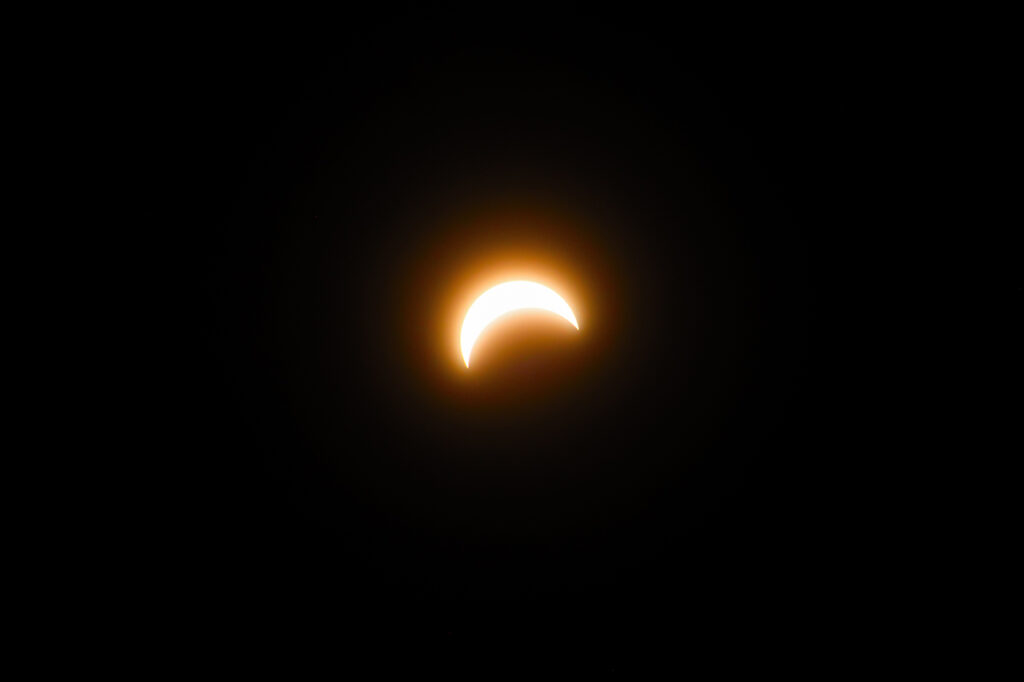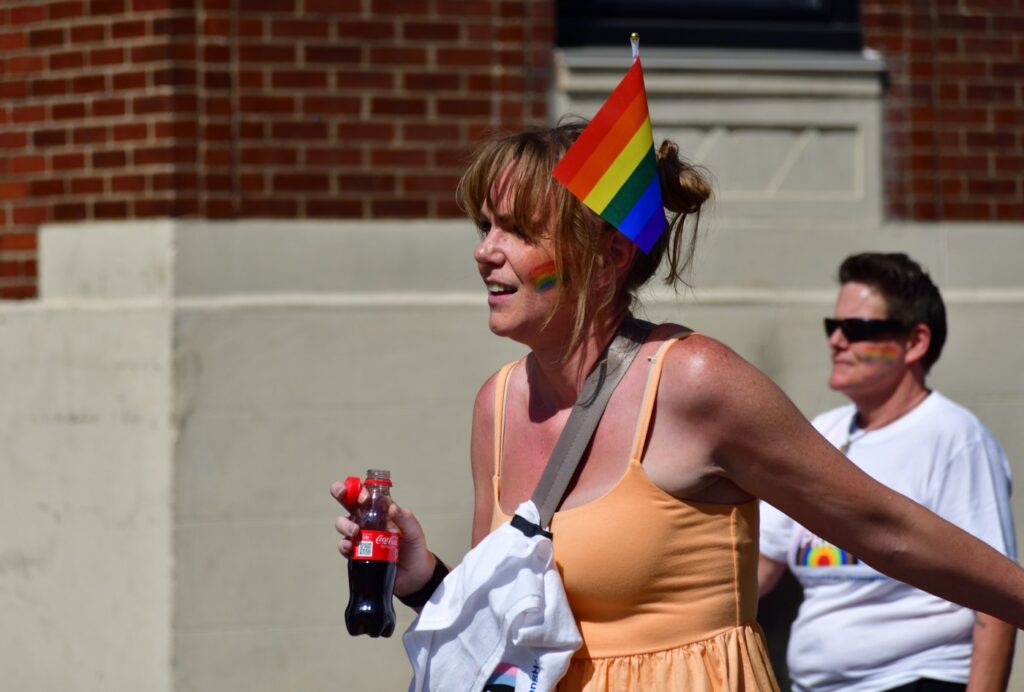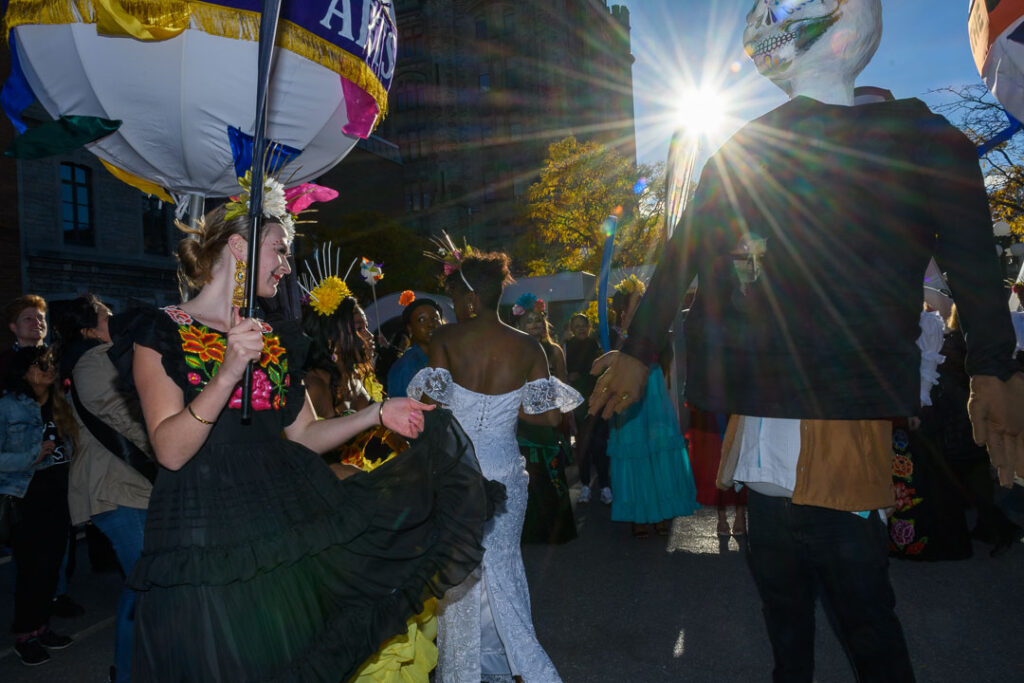Not really as good as I was hoping to get, but these two photos represent two approaches to solar eclipse photography, neither of which required any photoshopping… like most of the heavily massaged and composited eclipse images you see in the media. They’re just a couple of single exposures shot raw and converted in Nikon’s free NX Studio raw converter. No masking or anything special applied whatsoever. It was just a matter of selecting one of Nikon’s standard picture styles and adjusting white balance appropriately. I then saved each photo as a TIFF file and used Adobe Lightroom Classic to upscale them with its Super resolution tool so I could crop them to a reasonable size in square format.
My equipment consisted of only my Nikon D7500 in all manual mode, an AF-P DX NIKKOR 70-300mm f/4.5-6.3G ED, a K&F ND100,000 solar filter and my 25 year old Manfrotto CLB 190 tripod with a ball head. Not really an adequate setup for professional eclipse photography.
For the first one, I wanted a bright and colourful photo that would approximate how you might see the eclipse approaching totality with your eclipse glasses if you happened to have telephoto eyes. This required an exposure 4 stops above what you would normally use for a typical astronomical photo of the sun.
In the second shot, I wanted the sunspots I knew would be visible on the sun’s crescent just before totality. This required a more standard exposure for the sun so as to not blow out the sunspots. The obvious one in the picture is really a grouping of six spots.
Tragically, I was not successful in getting a photo of the total eclipse corona. Doing this required quickly unscrewing the solar filter off the lens and readjusting both focus and exposure in a very short time, with the eclipse moving surprisingly fast out of the frame while doing that. Unfortunately, while my DSLR is deadly fast and accurate when shooting in optical viewfinder mode, it’s not nearly as good when shooting in live view on the rear LCD. Using live view mode was necessary because my glass solar filter does not provide sufficient eye protection when looking through the optical viewfinder. This type of filter is only safe for the camera itself.
My consumer-level zoom also made it virtually impossible to simply focus manually at infinity, because it does not have focus markings. So, to make a long story short, I was not able to re-acquire focus on the corona fast enough after I removed the solar filter, and I had to give up on it so I could have time to look at the corona with my eclipse glasses before it was too late. Disappointing for sure, but I knew ahead of time my gear might not be ideal for this kind of work.
I’m just happy I got to see the total eclipse at all, because I had been planning to see it from a park in downtown Ottawa, which was just north of totality with a 98.8% deep partial eclipse. There’s just no comparison between a partial eclipse and the total eclipse that would occur a mere 80 km down the highway near the St Lawrence Seaway, but I had no way to get there, and so in the days leading up to it, I had only rehearsed with the mid-afternoon sun in approximately the same place in the sky it would be during the eclipse. My autofocus worked fine for this, but I could not anticipate that it wouldn’t grab focus on the total corona phase, probably because the corona is much dimmer and lower contrast than the rest of the eclipse leading up to it.
My younger brother saved the day when he decided on the morning of the eclipse to drive there and asked if we wanted to come along. It still wasn’t a sure thing though, because it was expected to be cloudy, and since we left only an hour before the start of the eclipse, the traffic might have been too heavy to get there in time. In the end, we reached Morrisburg (Ontario) in time to see the whole thing perfectly from a grassy area next to a service centre / McDonald’s parking area.
Useless note to self for a next opportunity I will never have at my age:
A camera and lens combo more suitable for manual focusing is a must, and despite some of the expert recommendations you can see on YouTube, a 450mm full-frame equivalent telephoto is not long enough to adequately fill the frame with the eclipse, while being too long for anything else. Also, mounting the camera on an astronomical star tracker is highly advisable, because even with a 450mm lens, the eclipse moves fast enough that’s it’s hard to keep it in the frame as you go about taking photos at intervals during the eclipse. A star tracker keeps it there automatically, and you can just set the camera’s intervalometer to take photos at whatever interval you want while you enjoy the eclipse.
I can’t be too sad about not getting the short-lived corona though, because I was extremely lucky to have seen it in its full glory with my own eyes, especially considering that many people from the Ottawa area had flocked to the heavily hyped locations that ended up being clouded over, including the town of Brockville not too far west of where we were in Morrisburg. I didn’t feel any spiritual experience or connection to a higher power like the many people interviewed on the various news media coverage. I mean, it’s just an astronomical and geographical alignment that happens relatively often somewhere on the surface of the planet. It’s just rare at any given location. It sure was exciting to finally see a corona though.

My sorry little eclipse photography setup in Morrisburg (Ontario), not far from the St Lawrence Seaway. Photo courtesy of my younger brother Robert Lachaine. He just used his phone and got some great environmental shots. Oddly enough, he’s usually the serious photographer.





